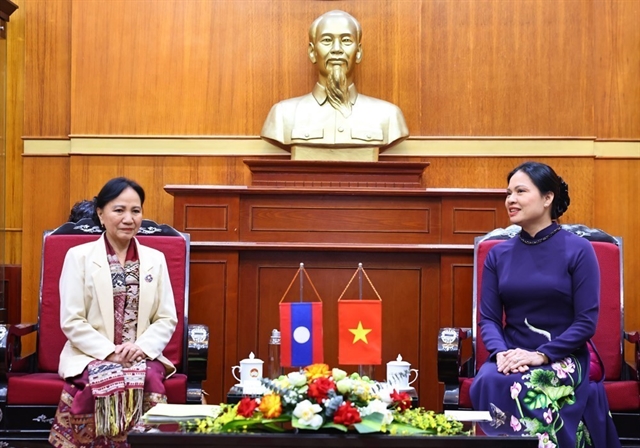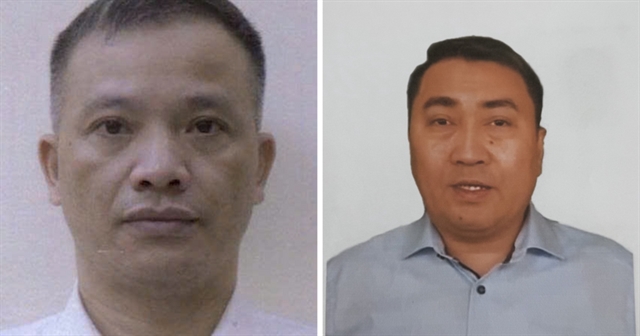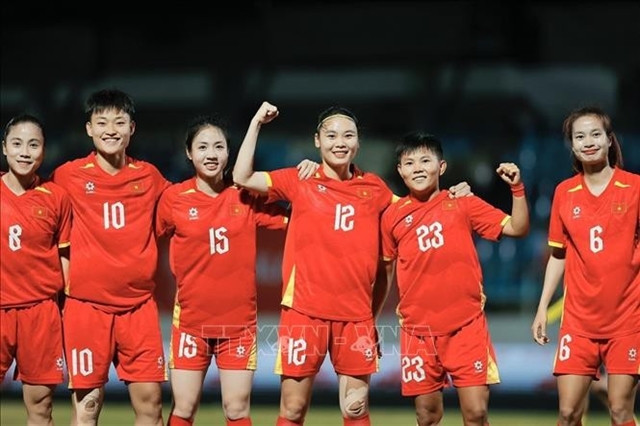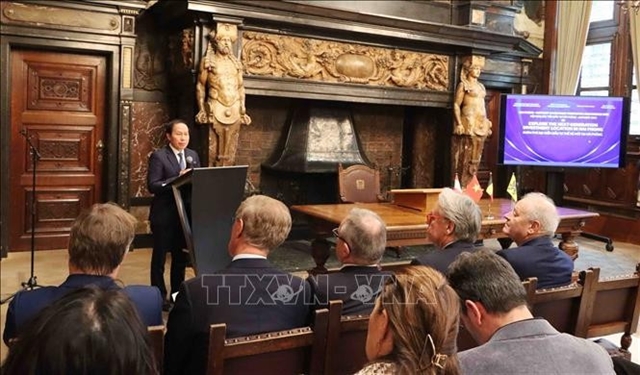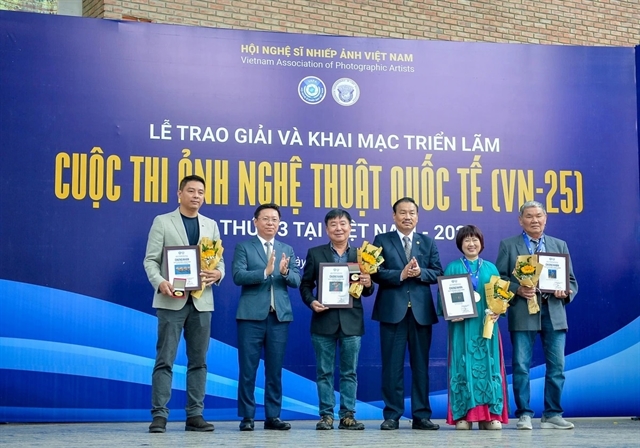 Life & Style
Life & Style

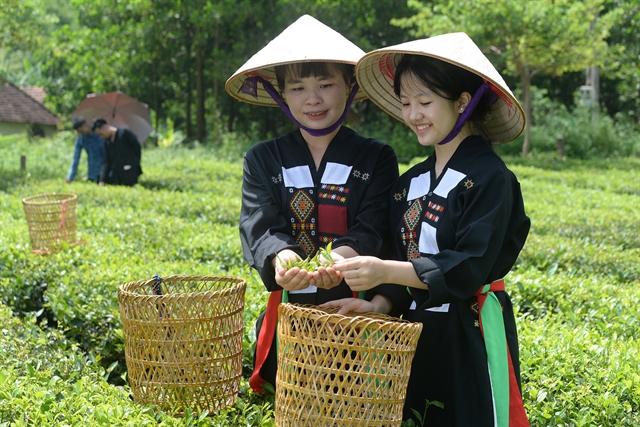 |
| Cao Lan girls in Xuân Lương Commune, Yên Thế District. |
BẮC GIANG — Bắc Giang is a region where ethnic groups make up 14.26 per cent of the population and mountainous areas account for nearly 73 per cent of the landscape. The province has four districts with significant populations of ethnic groups: Sơn Động, Lục Ngạn, Lục Nam and Yên Thế.
The ethnic communities in Bắc Giang carry traditional cultural and historical values closely linked to the lives of local residents. In recent years, provincial and local authorities have prioritised resources to preserve and promote traditional culture and festivals in regions populated by ethnic groups. This effort has deepened understanding of the spiritual values of these communities.
Sơn Động District is home to many ethnic groups, each with a unique cultural identity. In Tuấn Sơn village, the Dao Lô Gang ethnic group has preserved their cultural practices, particularly the traditional hand embroidery skills of the Dao women, which have become a significant aspect of their cultural identity.
A distinctive feature of the Dao in Tuấn Sơn is their traditional clothing. To preserve their cultural values, while not engaged in farming, Dao Lô Gang women gather to diligently embroider and teach each other. Đặng Thị Xuân, a local woman, shared that she learned the craft from her parents at the age of ten, making the intricate embroidery techniques second nature to her.
“I want to continue this embroidery tradition to prevent it from fading, and I want to pass it down to my children and others so that we can all have Dao clothing to wear during festivals, allowing others to recognise us as Dao people,” Xuân said.
Tuấn Sơn Village was resettled from a National Shooting Range area. By 2005, it had 70 households with nearly 300 residents, all from the Dao ethnic group. Despite recent economic difficulties, the Dao people in Tuấn Sơn have received support from the Government in infrastructure development, agriculture and forest planting, yielding an annual income of VNĐ50 million per household.
All homes have been built sturdily, and the poverty rate has steadily decreased. Residents are seeing daily improvements in their village, with new buildings and economic growth helping eliminate food insecurity. This progress is attributed to the collective effort of the community.
Notably, the preservation of traditional cultural values is also a priority for local people. Dao women continue to share their knowledge of embroidery and traditional clothing. The quality of their embroidery products has become increasingly refined, helping to uphold and spread Dao culture, which is rich in Vietnamese ethnic identity.
Nearly 63 per cent of the population of Sơn Động District belongs to ethnic groups, with the Dao making up about 12.5 per cent. The Dao in Sơn Động have many distinctive cultural traits that are being promoted. Triệu Thị Bình, a Dao Lô Gang woman from Gà Village in Vân Sơn Commune, is committed to preserving her ethnic culture through practical actions, such as maintaining the Dao script and language, participating in cultural clubs and continuing the tradition of hand-sewing clothing for her family.
La Thị Mỹ, president of the Women's Union in Tuấn Đạo Commune, said: “To implement the project of expanding Dao tourism in Tuấn Sơn Village, we have established a club and collaborated with the district's Women's Union to support operational funding. We plan to maintain embroidery skills and preserve the language. To promote ethnic cultural identity, language is as important as embroidery.”
Bình said: “The culture of the Dao people is very special. I want to maintain our identity through practices like embroidery and traditional singing, and I hope everyone in the community will continue our cultural traditions.”
Gà Village has 210 households, 40 per cent of which are from the Dao Lô Gang ethnic group. It is not difficult to find villagers who can play traditional instruments, embroider and sew Dao clothing. To preserve and promote these activities, the women's association in Gà Village, along with the Vân Sơn Commune’s People’s Committee, has actively encouraged and guided children to participate in cultural and artistic activities, maintaining the unique traditions of their ethnic community.
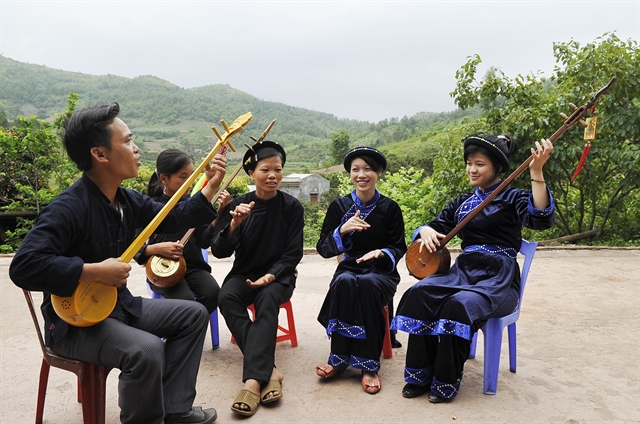 |
| Local residents practice đàn Tính in Sơn Hải Commune, Lục Ngạn District. |
Lê Hồng Sơn, vice chairman of Vân Sơn Commune’s People’s Committee, said: “Preserving the cultural identity of the Dao people here involves artistic performances related to the community, teaching the Dao script and language, and passing on embroidery techniques to the Dao people in Vân Sơn Commune. This is a bright spot for inspiring women in Gà Village and preserving the cultural identity of the Dao people in Vân Sơn.”
Nguyễn Văn Thức, head of the Culture and Information Department in Sơn Động District, stated: “The community has recognised the importance of preserving their culture. With the support of the Government, the Dao people are eager to invest their own resources and efforts to teach their children the unique dances and folk songs of their ethnic group, contributing to the preservation and promotion of their cultural values.”
A resolution of Sơn Động District's 26th Party Congress for the 2020-2025 term identifies the preservation and promotion of the cultural heritage of ethnic groups as an urgent, ongoing and long-term task. Each year, the district prioritises funding for cultural infrastructure, establishing clubs for traditional culture and arts.
Since the beginning of the term, the district has focused on preserving and enhancing 17 historical-cultural sites and has organised 13 classes to teach ethnic communities' intangible cultural heritage, as well as restoring 10 wedding rites of the Dao, Cao Lan and Tày ethnic groups. In 2022, district authorities issued a plan for the preservation and promotion of the Sơn Động ethnic groups' cultural heritage.
In 2023, Sơn Động District allocated nearly VNĐ5 billion for investment in the national target programme for socio-economic development in ethnic minority and mountainous areas, establishing community tourism sites in Nà Ó Village, An Lạc Commune; Mậu Village, Tây Yên Tử Town; Nà Hin Village, Vân Sơn Commune; and ecological tourism at Khe Chảo Lake, Long Sơn Commune; Khe Nương Dâu, Tuấn Đạo Commune; and Mục Mountain in the Tây Yên Tử area.
Aside from the historical sites and the Tây Yên Tử scenic area proposed for special national heritage status, Sơn Động District is collaborating with the Bắc Giang Department of Culture, Sports and Tourism to list the boat racing festival in An Châu Town as a piece of national intangible cultural heritage. Other cultural festival activities include restoring the legend of the Tiên Well and Đá Đĩ Stone in the Tây Yên Tử spiritual-ecological tourism area, Cao Lan folk singing, the Dao ethnic group's rituals and Tày ethnic group’s Then singing, as well as playing the đàn Tính (a stringed musical instrument from China imported into Việt Nam by the Tày people).
Tống Thị Hương Giang, vice chairman of Sơn Động District, stated: “The festivals and cultural activities of the ethnic groups, like the Tắc xình dance, Then singing, đàn Tính and the Páo Dung songs of the Dao, along with the rituals for new crops, take place within festival frameworks to preserve and promote the cultural values of the ethnic groups linked to boat racing festivals. We also aim to integrate tourism development as a unique potential of the district. During festivals, we will showcase the region's cultural heritage and attract domestic and foreign visitors to Sơn Động to experience and learn about the land and people here.” VNS

